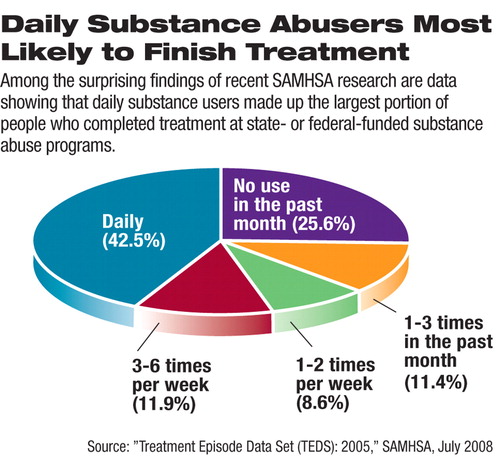Substance Abuse Treatment Findings Counter Common Belief
A higher percentage of participants in substance abuse programs complete treatment than the public may realize, according to a recent federal report.
An annual report on discharges at state- and federal-funded treatment facilities in 34 states found that treatment was completed by 41 percent of the nearly 1.5 million people admitted for treatment since 2002.
Among those who did not complete treatment, 13 percent were transferred to a hospital residential treatment program for further care, 24 percent dropped out of treatment, 8 percent had treatment terminated by the facility staff, 2 percent had treatment terminated because of incarceration, less than 1 percent died, and 7 percent failed to complete treatment for other reasons. The reason for discharge was unknown for 6 percent of program participants.
The relatively high rate of overall treatment completion stood out among the findings of the report—titled “Treatment Episode Data Set (TEDS): 2005”—to Petros Levounis, M.D., M.A., chair of APA's Corresponding Committee on Treatment Services for Patients With Addictive Disorders.
“This is significantly higher than what the general public and a lot of psychiatrists have predicted,” Levounis said. “We usually think about patients who suffer from substance use disorders as noncompliant with treatment.”
The report, compiled by the Substance Abuse and Mental Health Services Administration, aims to help clinicians and public-health policymakers better understand the scope and nature of treatment episodes to better tailor their treatment approaches.

The treatment completion rate was highest among those in hospital residential treatment (67 percent), detoxification (65 percent), and short-term residential treatment (56 percent) programs, according to the report. Lower completion rates were found among those in longer-term and less-structured settings. The treatment completion rate was 39 percent in long-term residential programs and 36 percent in “intensive” outpatient plans and other outpatient treatment.
The relatively high completion rates were striking to Levounis because many of those are from long-term treatment programs that require a sustained commitment of months or even years.
The lowest completion rate was among discharges from opioid-replacement therapy programs (19 percent). Among addicts in these programs, treatment completion rates ranged from a high of 35 percent of participants in opioid-replacement detoxification programs to a low of 11 percent in outpatient opioid-replacement therapy plans.
The relatively low rate of success in opioid-treatment programs may be driven by the overall approach among many such programs, which maintain that long-term maintenance is more realistic than substance use elimination, according to Levounis.
Among the surprising findings of the report was that people who were using drugs and alcohol on a daily basis were more likely to complete treatment than were less-frequent users.
“One would expect that if you didn't use daily perhaps you would suffer from a less severe form of addiction and you would have a higher rate of completion,” Levounis said.
Other factors associated with higher rates of completion included alcohol rather than drug use, being over age 40, having 12 or more years of education, referral to treatment by the criminal-justice system, being employed, and being male.
The strongest predictor of treatment completion was the use of alcohol rather than other drugs. Patients who were in all types of treatment programs combined were 82 percent more likely to complete treatment or transfer to further treatment if their primary substance of abuse was alcohol, after taking into account other possibly confounding characteristics.
The findings were derived using an episode-based system, which means the data used to evaluate discharges do not directly correspond to the number of individuals discharged from treatment programs in a given year. The data do not include all admissions to substance abuse treatment programs, rather only those licensed or certified by state substance abuse agencies. Most of these facilities receive state or federal block-grant funds.
A copy of “Treatment Episode Data Set (TEDS): 2005” is posted at<wwwdasis.samhsa.gov/teds05/TEDSD2k5TOC.htm#tables>.▪



